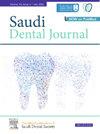The effect of different pretreatments and cleaning methods prior to adhesive cementation of lithium disilicate restorations. In vitro study
IF 2.3
Q3 DENTISTRY, ORAL SURGERY & MEDICINE
引用次数: 0
Abstract
Aim
This study aimed to evaluate the bond strength of adhesively cemented lithium disilicate restorations to dentin by applying different pretreatments and cleaning methods.
Material and Methods
Twenty-five human posterior teeth were mounted in an acrylic mold, flattened to expose mid-coronal dentin, and divided into five groups based on different pretreatments and cleaning methods prior to adhesive cementation. After cementation, the teeth were sectioned to obtain 1 mm2 specimens, yielding 15 specimens in each group that were subjected to aging and thermocycling process, followed by a microtensile bond test and failure mode assessment.
Results
The highest bond strength values were in the control group and in the group that was treated with fluoride and where the temporary cement was removed using pumice, whereas the lowest values were in groups that were cleaned by excavator irrespective of whether they were treated with fluoride or not. However, all groups showed mainly cohesive failure without any statistically significant differences.
Conclusions
To eliminate any possible negative impact of eugenol on adhesion to dentin, surface cleaning by rotational brush and pumice is recommended prior to cementing lithium disilicate restorations.
不同预处理和清洗方法对二硅酸锂修复体胶结的影响。体外研究
目的通过不同的预处理和清洁方法,评价二硅酸锂粘接修复体与牙本质的结合强度。材料与方法将25颗人后牙固定在丙烯酸模中,压平暴露冠状中牙本质,根据不同的预处理方法和粘接剂粘合前清洁方法分为5组。粘接完成后,对牙齿进行切片,得到1 mm2的试件,每组15个试件进行老化和热循环过程,然后进行微拉伸粘结试验和破坏模式评估。结果胶结强度值以对照组和氟处理组及浮石清除临时水泥组最高,而无论是否氟处理均以挖掘机清理组最低。但各组均以内聚失败为主,差异无统计学意义。结论为了消除丁香酚对牙本质粘附的负面影响,建议在二硅酸锂修复体粘接前使用旋转刷和浮石进行表面清洁。
本文章由计算机程序翻译,如有差异,请以英文原文为准。
求助全文
约1分钟内获得全文
求助全文
来源期刊

Saudi Dental Journal
DENTISTRY, ORAL SURGERY & MEDICINE-
CiteScore
3.60
自引率
0.00%
发文量
86
审稿时长
22 weeks
期刊介绍:
Saudi Dental Journal is an English language, peer-reviewed scholarly publication in the area of dentistry. Saudi Dental Journal publishes original research and reviews on, but not limited to: • dental disease • clinical trials • dental equipment • new and experimental techniques • epidemiology and oral health • restorative dentistry • periodontology • endodontology • prosthodontics • paediatric dentistry • orthodontics and dental education Saudi Dental Journal is the official publication of the Saudi Dental Society and is published by King Saud University in collaboration with Elsevier and is edited by an international group of eminent researchers.
 求助内容:
求助内容: 应助结果提醒方式:
应助结果提醒方式:


